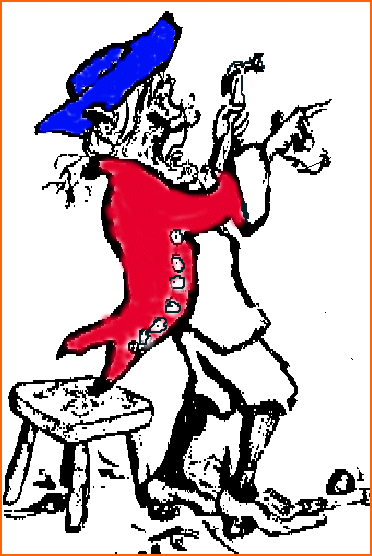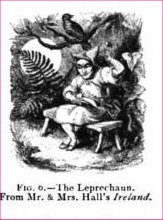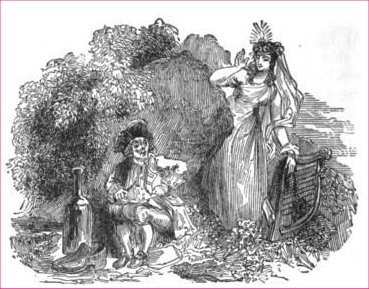|
Leprechauns in Lives of the Saints-
Second Voyage of St. Brendan of Clonfert
xxxiii. HERE 1s THE STORY OF
THE ISLE OF DWARFS. (
95) After leaving this place they saw a little insignificant country
near them. And as they were landing there, the harbour was filled
with demons in the shapes of dwarfs and leprechauns opposing them,
whose faces were black as coal. Then said Brendan: ' Let go the
anchor, for no one can enter this land but one who shall wage human
war against demons, and shed blood over them.' They remained
there till the end of seven days and seven nights, and they could not
draw up their anchor, and
they left it there, stuck between the rocks,
and then quitted the harbour.
Notes.
95. ' Dwarfs and Leprechauns ' = in formis quasi
pigmeorum, R. The
word luchurpdn (lit. little body) occurs in many forms, and is the Anglo-
Irish 'Leprechaun', a kind of fairy. In Rawl. B. 502 f. 41°. 5, these
beings are said to be the offspring of the unlawful intercourse of the
chilren of Seth with those of Cain; but according to ib. f. 42*'. 47 (||LU 2*
45) they are the descendants of Ham after he had been cursed by his
father. The qualification for entering the demon isle differs from the
Latin : ' nisi is qui bella humana gerit, et sanguinem fundit.'
-From:Bethada Naem NErenn-Lives of the Irish Saints,
Charles Plummer, 1922
It appears that it
is all in translation. Clearly Brendan did not meet a race of little leather
workers with crocks of gold. It seems that Dwarf's or little people were surely
the ones.....
to return to the top click here
The
Research of Evans-Wentz
From the work of
Evans-Wentz you receive an image of the Leprechaun or small, yet
perfect in every way who inhabits rocks or caves and guards a sack
of gold. His hat is red and sometimes he is to be found near springs.
The leprechaun has several distinct virtues: He is crafty and can
not be caught. When caught he must be honest and grant requests or
tell you where his money is.
He is also
generous- when caught he will hive his money away without a fight.
Having put so much
gold aside he must be a hard worker and must also be thrifty.
The Leprechaun is
not a Gnome or dwarf- he is "perfect in every way". Dwarfs
and Gnomes have
big heads and stubby bodies. Although perfect in his small way his perfection
is that of a worker and craftsman and not that of the more aristocratic
and well dressed Gentry who are beings who are small and resemble
the aristocracy. The Leprechaun is a well dressed craftsman and appears
as a shoemaker.
One wonders - Why
would such an ordinary leather worker be so elevated?
Perhaps this importance
of the leather worker is quite ancient and derives from a time before
metals when Leather was one of the most important materials being
used for everything from clothes to dishes to armor?
Evans-Wentz
provides primary records concerning the Leprechaun as
known by Irish men and women of the 19th century.
From:
The Fairy-Faith in Celtic Countries
W.Y. Evans-Wentz
1911
( Humanities Press, Atlantic Highlands, N.J. 1978)
“My mother once saw a leprechaun beside a bush hammering. He disappeared
before she could get to him, but he also was unlike one of the gentry.”-p47
Peasant Seer, County Sligo
“The leprechaun is a red-capped fellow who stays round pure springs,
generally shoemaking for the rest of the fairy tribes”- p.52 Patrick Waters,
Tailor, Cloontipruckilish
“One day ,in her girlhood, near a hedge from which she was gathering
wild berries she saw a leprechaun in a hole under a stone:--He wasn ‘t
much larger than a doll, and he was most perfectly formed , with a little
mouth and eyes. Nothing was told about the little fellow having a money-bag,
although the woman said people told her afterwards that she would have
been rich if she had only had sense enough to catch him when she had so
good a chance.”- p;71 Dr. Hyde, Ratra
“....a leprechaun which had been appearing to school-children and to
many of the country-folk. .....Most of them were certain that there could
be such a creature showing itself....were all quite anxious to have a chance
at the money-bag, if they could only see the little fellow with it.
I told one good natured old Irishman at Ballywillan......that the leprechaun
was reported as captured by the police in Mullingar. “Now that couldn’t
be, at all, “ he said instantly, “for everybody knows the leprechaun is
a spirit and can’t be caught by any blessed policeman, though it is likely
one might get his gold if they got him cornered so he had no chance to
run away. But the minute you wink or take your eyes off the little
devil, sure enough he is gone.”- p. 71 ,Ballywillan and Mullingar.
“The leprechaun indicates the place where hidden treasures is to be
found. If the person to whom he reveals such a secret makes it known
to a second person, the first person dies, or else no money is found:
In some cases the money is changed into ivy leaves or into furze blossoms.”
-P.82 Lough Gur
“The testimony of Celtic literature goes to show that leprechauns
and similar dwarfish beings are not due to a folk memory of a real pygmy
race, that they are spirits like elves, and that the folk memory
of a Lappish-like people (who may have been Picts) evidently was
confused with them so as to result in their being anthropomorphosed.....
While asleep on the seashore one day, Fergus was about to be carried of
by the luchorpdin whereat he awoke and caught three of them to wit,
one in each of his two hands and one on his breast. “Life for life”
(i.e. protection) say they. “Let my three wishes (i.e.) choices be
given,” says Fergus. “Thou shalt have,” says the dwarf “save one
which I forbid thee: thou shalt not go under Lough Rudraide (which) is
in thine own country.” There after the luchuirp (little bodies)
put herbs into his ears, and he used to go with them under seas.” In an
etymological comment on this passage, Sir John Rhys says: “ The words luchuirp
and
luchorpain (Anglo-Irish leprechaun) appear to bean literally
“small bodies”, and the word here rendered dwarf is in the Irish abac,
the etymological equivalent of the Welsh avanc, the name by which
certain water inhabitants of a mythic natuer went in Welsh...”-p.237
“Among the usually invisible races which I have seen in Ireland I distinguish
five classes:
1. There are the Gnomes who are earth-spirits, and who seem to be a
sorrowful race. I once saw some of them distinctly on the side of
Ben Bulbin. They had rather round heads and dark thick set bodies,
and in stature were about two and one half feet.
2. The Leprechauns are different, being full of mischief, though they,
too, are small. I followed a leprechaun from the town of Wicklow
out to the Carraig Sidhe, “Rock of the fairies, “ a distance of
half a mile or more, where he disappeared. He had a very merry face,
and beckoned to me with his finger”-p243, Mrs. X a cultured Irishwoman
living in County Dublin.
The Observations of D.
R. McAnally Jr,1900
'...a little red jacket or roundabout, with red breeches buckled at the knee,
gray or black stockings, and a hat, cocked in the style of a century ago [that
would be 1800, dear reader], over a little, old, withered face. Round his neck
is an Elizabethan ruff, and frills of lace are at his wrists.
'On the wild west coast, where the Atlantic winds bring
almost constant rains, he dispenses with ruff and frills and wears a frieze
overcoat over his pretty red suit, so that, unless on the lookout for the cocked
hat, "you might pass a leprechaun on the road and never know that it's himself
that's in it at all."'
There are variations: the leprechaun family was a diverse
one; and each area of the country had its own name for the leprechauns living in
the region. Each of these had its own style, which McAnally described:
- The Logheryman of the Northern counties wears the uniform of some British
infantry regiments, a red coat and white breeches, but instead of a cap, he
wears a broad-brimmed, high, pointed hat, and after doing some trick more than
usually mischievous, his favorite position is to poise himself on the extreme
point of his hat, standing at the top of a wall or on a house, feet in the
air, then laugh heartily and disappear.
- The Lurigadawne of Tipperary wears an antique slashed jacket of red, with
peaks all round and a jockey cap, also sporting a sword, which he uses as a
magic wand.
- In Kerry, the Luricawne is a fat, pursy little fellow whose jolly round
face rivals in redness the cut-away jacket he wears, that always has seven
rows of seven buttons in each row, though what use they are has never been
determined, since his jacket is never buttoned, nor, indeed, can it be, but
falls away from a shirt invariable white as the snow. When in full dress he
wears a helmet several sizes too large for him, but in general, prudently
discards this article of headgear as having a tendency to render him
conspicuous in a country where helmets are obsolete, and wraps his head in a
handkerchief that he ties over his ears.
- The Cluricawne of Monaghan is a little dandy, being gorgeously arrayed in
a swallow-tailed evening coat of red with green vest, white breeches, black
stockings, and shoes that "for the shine of them would shame a looking glass."
His hat is a long cone without a brim, and is usually set jauntily on one side
of his curly head. When greatly provoked, he will sometimes take vengeance by
suddenly ducking and poking the sharp point of his hat into the eye of the
offender. Such conduct is, however, exceptional, as he commonly contents
himself with soundly abusing those at whom he has taken offense, the objects
of his anger hearing his voice but seeing nothing of his person.-From:
The Leprechawn, D. R. McAnally Jr,1900
to return to the top click here
What it is all About this
Leprechaun Whatever you do or think should be never think that we
should all agree! Disagreement and free ranging personal opinion is a dear trait
of the Celtic culture. Everything is interpreted. And that is the only firm law
that exists. Even though small people do turn up in the voyage of St. Brendan
they don't seem to have been Leprechauns. Some have equated them with the Tuatha
de Dannan but they don't appear in any form of leprechaun sense in the ancient
stories. Most likely the leprechaun originated in the post Celtic period with
the peasantry. This is not to say that I do not believe...but that the
revelation came later in time. What then does one do with the disagreement?
Green, yellow, red, gold...bad, crafty good....conical hats, three corner hats,
slightly nasty, very nice.... The best way to deal with this is to expect that
the Leprechaun can dress and behave as he pleases and to acknowledge the mystery
of it all - something that human's can't quite describe adequately. The
leprechaun may just be a mystery beyond our grasp. The Irish have described in
the person of the leprechaun an amorphous yet knowable and realizable cloud of
attributes- most of them in one context or another admirable. The cloud of
mystery can not be seen unless it is papered over with story attached to it to
give it shape. Sometimes there are gaps in the covering of this transparent
entity but generally once covered it can be seen and described. Here are a few
of the attributes of the leprechaun that have been cobbled together by story to
reveal him to us: 1. The Leprechaun is a professional- In ancient Celtic times
leather would have been worked much as were metals. The use of leather pre-dated
the use of metals so the leather worker would have been a very important
specialist and of high rank in the community.
2. He would have made a fair amount of income-as he was a hard worker. As a
professional the Leprechaun is well dressed. He is not a member of the gentry
but his clothes do fit and he looks good on the street. 3. The Leprechaun was
also thrifty- he saved his money and stored it away. How else would he have so
many crocks of gold? A wonderful trait! 4. Leprechauns followed rules. When
they were caught they had to do what they had to do and this is done without
exception. One might think of this as a great way of instilling the concept of
reciprocity.
5. Honesty is also a trait of the Leprechaun- when caught the answer must be
true. 6. The Leprechaun drinks alcohol but he does not get drunk. He might get
tired and go to sleep but when awakened he is sober and crafty. 7. My favorite
aspect of the Leprechaun is the most Celtic. The Leprechaun is crafty, and sly.
He does not trick people or take advantage of them. He simply catches them in
their human failings. Word games that they could win by thinking they loose to
the master Leprechaun. What a better trait in a peasant - the ability to live
upon the edge of the law, spotting and exploiting loopholes legally. So...when
you find a need to talk about these values take out the stories and
attach them to the amorphous cloud and you will find inside the form of the
Leprechaun. Use these stories to let others see him and the values he
represents.
If you see a Leprechaun that is not quite right- look for the stories that
are used to reveal him. Where did they come from? If not from the Irish
peasantry then away with them.
to return to the top click here |

 sub-cultures such
as Irish-Americans are quite content with the image of the
Leprechaun as overweight, alcoholic, pipe smoker with ill
fitting clothing that they put up everywhere
around St. Patrick's Day (March 17). While I would not wish
to deny any group their Icons, I do want to provide an alternate
image which is based upon scholarship and oral historical
accounts. Start with the
only reference to the Leprechaun or perhaps translators inserting the
term, in
the Ancient Irish Tales. Click
here Next consult the extensive research
of Evans Wentz Just click. Then go on to read of the stories and sayings
about the Leprechauns click
here. Ok then in a nutshell what is it all about?
Click here then!
Dennis King has found the following words in Irish Gaelic
to be related to the Leprechaun. He has discovered that "luchorpán",
the earliest version was used in the 8th century in "Echtra Fergusa
maic Léti". It was then a type of water sprite. lochramán
loimreachán loragádán lucharachán lucharbán
luchargán lucharpán luchorp luchorpán luchragán,
luchramán, luchrupán, lupracán, luprachán ,lúracán,
lúrapóg, lurgadán , clúracán ,clúrachán,
clutharachán.
sub-cultures such
as Irish-Americans are quite content with the image of the
Leprechaun as overweight, alcoholic, pipe smoker with ill
fitting clothing that they put up everywhere
around St. Patrick's Day (March 17). While I would not wish
to deny any group their Icons, I do want to provide an alternate
image which is based upon scholarship and oral historical
accounts. Start with the
only reference to the Leprechaun or perhaps translators inserting the
term, in
the Ancient Irish Tales. Click
here Next consult the extensive research
of Evans Wentz Just click. Then go on to read of the stories and sayings
about the Leprechauns click
here. Ok then in a nutshell what is it all about?
Click here then!
Dennis King has found the following words in Irish Gaelic
to be related to the Leprechaun. He has discovered that "luchorpán",
the earliest version was used in the 8th century in "Echtra Fergusa
maic Léti". It was then a type of water sprite. lochramán
loimreachán loragádán lucharachán lucharbán
luchargán lucharpán luchorp luchorpán luchragán,
luchramán, luchrupán, lupracán, luprachán ,lúracán,
lúrapóg, lurgadán , clúracán ,clúrachán,
clutharachán.
